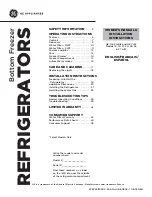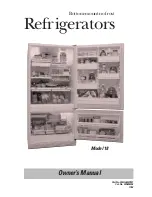
14
14
14
Fridge and freezer
The fridge is not chilling (and the
freezer is not freezing).
• Is the power to the refrigerator on?
The fridge is not chilling (and
the freezer is not freezing)
satisfactorily.
• Is the set temperature too high?
• Is the refrigerator exposed to direct sunlight or positioned near a heating
appliance?
• Have sufficient clearances been provided around the refrigerator?
• Have the food items been packed too tightly together or is the room
temperature high?
• Have the doors been opened and closed frequently?
Are the doors completely shut?
• When warm food is put inside the refrigerator, the temperature will rise
temporarily.
• During the cold season or when the room temperature is low, it may feel as if
the refrigerator is not chilling.
• If room temperature is low, the freezer may not cool properly.
In this event, please change the temperature setting to 3 °C or lower.
There is a difference between
the set temperature and actual
temperature.
• When warm food is put inside the refrigerator, the temperature will rise
temporarily.
Food in the fridge freezes.
• Is the set temperature for the fridge too low? Alternately, is Super Cool Mode
set to Active?
• Has the food been placed at the back of the fridge?
The area near the back wall is where the temperatures are coldest so avoid
placing food which may freeze easily here.
Condensation forms in the fridge
and drawers.
• Condensation may form when the door has been opened and closed frequently
or when it has not been shut completely, or when the room humidity is high.
Wipe off the condensation using a dry cloth.
Condensation forms on interior
refrigerator walls (internal
compartment)
• Condensation may form when the temperature is high, when the door has
been open for an extended period, when the door is repeatedly opened and
closed, and in similar situations. Furthermore, as the back surface of the
internal compartment is the condenser, frost may form on it, melt, and become
condensation, but this is not a malfunction.
It is hard to open the freezer door. • The door is sometimes difficult to open just after it has been closed.
• The difference in air pressure between the inside and outside of the freezer
may sometimes make it hard to open the freezer door. Wait a few moments,
and then try opening the door.
It smells inside the refrigerator.
• Were any food items with strong odours sealed before they were placed in the
fridge?
Place the items inside a sealed container and store them.
• Odours may stick to the surfaces inside the refrigerator. Wipe the surfaces
using a soft cloth which has been dipped in lukewarm water.
This symbol is used to refer users to the instructions or leaflets for relevant information.
This refrigerator incorporates a filter, which is considered a biocidal product.
The filter itself incorporates a substance containing silver ions which deactivates bacteria in the air inside the
refrigerator and inhibits bacterial growth.
Active substance: Silver sodium hydrogen zirconium phosphate
FAQs
(continued)















































